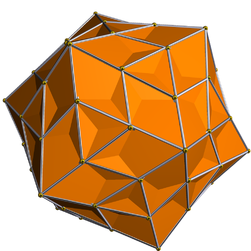Snub dodecadodecahedron
| Snub dodecadodecahedron | |
|---|---|
 | |
| Type | Uniform star polyhedron |
| Elements | F = 84, E = 150 V = 60 (χ = −6) |
| Faces by sides | 60{3}+12{5}+12{5/2} |
| Coxeter diagram |        |
| Wythoff symbol | | 2 5/2 5 |
| Symmetry group | I, [5,3]+, 532 |
| Index references | U40, C49, W111 |
| Dual polyhedron | Medial pentagonal hexecontahedron |
| Vertex figure |  3.3.5/2.3.5 |
| Bowers acronym | Siddid |

In geometry, the snub dodecadodecahedron is a nonconvex uniform polyhedron, indexed as U40. It has 84 faces (60 triangles, 12 pentagons, and 12 pentagrams), 150 edges, and 60 vertices.[1] It is given a Schläfli symbol sr{5⁄2,5}, as a snub great dodecahedron.
Cartesian coordinates
Let be the smallest real zero of the polynomial . Denote by the golden ratio. Let the point be given by
- .
Let the matrix be given by
- .
is the rotation around the axis by an angle of , counterclockwise. Let the linear transformations be the transformations which send a point to the even permutations of with an even number of minus signs. The transformations constitute the group of rotational symmetries of a regular tetrahedron. The transformations , constitute the group of rotational symmetries of a regular icosahedron. Then the 60 points are the vertices of a snub dodecadodecahedron. The edge length equals , the circumradius equals , and the midradius equals .
For a great snub icosidodecahedron whose edge length is 1, the circumradius is
Its midradius is
The other real root of P plays a similar role in the description of the Inverted snub dodecadodecahedron
Related polyhedra
Medial pentagonal hexecontahedron
| Medial pentagonal hexecontahedron | |
|---|---|
 | |
| Type | Star polyhedron |
| Face |  |
| Elements | F = 60, E = 150 V = 84 (χ = −6) |
| Symmetry group | I, [5,3]+, 532 |
| Index references | DU40 |
| dual polyhedron | Snub dodecadodecahedron |

The medial pentagonal hexecontahedron is a nonconvex isohedral polyhedron. It is the dual of the snub dodecadodecahedron. It has 60 intersecting irregular pentagonal faces.
See also
References
- ^ Maeder, Roman. "40: snub dodecadodecahedron". MathConsult.
- Wenninger, Magnus (1983), Dual Models, Cambridge University Press, doi:10.1017/CBO9780511569371, ISBN 978-0-521-54325-5, MR 0730208
External links
- Weisstein, Eric W. "Medial pentagonal hexecontahedron". MathWorld.
- Weisstein, Eric W. "Snub dodecadodecahedron". MathWorld.
- v
- t
- e
polyhedra (nonconvex
regular polyhedra)
of Kepler-Poinsot
polyhedra
hemipolyhedra
uniform polyhedra
- medial rhombic triacontahedron
- small stellapentakis dodecahedron
- medial deltoidal hexecontahedron
- small rhombidodecacron
- medial pentagonal hexecontahedron
- medial disdyakis triacontahedron
- great rhombic triacontahedron
- great stellapentakis dodecahedron
- great deltoidal hexecontahedron
- great disdyakis triacontahedron
- great pentagonal hexecontahedron
uniform polyhedra with
infinite stellations
 | This polyhedron-related article is a stub. You can help Wikipedia by expanding it. |
- v
- t
- e

































